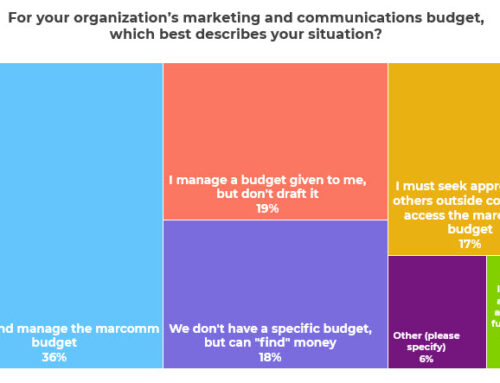We know from our Trends Report research and experience that measuring marketing and communications work is hard. Most nonprofits don’t really take it on in a meaningful way that influences their strategies (e.g. making real changes based on data) until they reach an “expert” level of experience.
So if you are just starting out with measurement, where should you begin, especially if you are fairly new to comms work or you are the first comms staffer at your nonprofit?
You have outputs (what you create–like an email fundraising campaign), outcomes (what people do with what you create–like opening, clicking, and donating), and impacts (the change that results–what you able to do with the money).
Yes, eventually you want to get to all three. But that’s hard at first.
So I suggest you start with Outputs, and specifically measure that in three ways:
- How much new content you are producing
- The frequency with which you are share content (original, repurposed, and curated) across your primary channels
- How consistent you are with meeting your ideal communications schedule
Let’s look at each of these a bit more, so you can see how to customize them for your work.
How Much New Content Did You Produce?
Content marketing is an essential strategy for nonprofits, so keeping track of how much original content you produce is a good start. I’m talking substantive content here, like articles, blog posts, and videos, not quick social media posts (that’s included next). Also look at the topics you write about.
Example: Last month, we wrote four original blog posts (two on Project A and two on Project B), seven original newsletter articles (two on Project A, and one each on Projects B, C, D, E, and F), and a press release (on Project D).
How Often Did You Share Content?
Sharing content at the right frequency is a real struggle for many nonprofits. Many don’t communicate often enough. So the pace at which you share content — how often you email, post to social etc. — is also an indicator of your potential effectiveness.
Count up how many times you posted or sent content through each of your major channels. This should include both original content AND repurposed content AND curated content — all of it.
Example: Last month, we created 8 blog posts, 4 email newsletters, 4 single topic emails, 1 press release, 12 Facebook posts, 12 Instagram posts, and 30 Tweets. You can also note how this volume compares to what you’d like to do and what topics were covered.
How Consistently Are You Meeting Your Editorial Schedule?
Now, the question is, did you share that content on a consistent schedule? If you do a whole bunch of social media posts at the beginning of the month, but then fall silent (or close) in the second half of the month, that’s not good. So take a look at the pattern — How closely were you able to follow your editorial calendar?
Example: The blog was updated on schedule. Two of the email newsletters went out more than a day late, because internal reviewers missed deadlines. Social media frequency is lagging — we posted about 3 times a week on Instagram and Facebook, but we want to post 5 times a week. We met our schedule for Twitter.
What’s Next
Tracking only this information may feel like you are missing important information, like outcomes — and you are! But it’s OK. You have to start somewhere, and we know that creating original content, sending content frequently, and sticking to a consistent schedule are super important to your success. Work on that first, and then you’ll be in great shape to measure the effectiveness of the content.
If you are ready to move beyond measuring your content production, then I recommend you ask these five questions to decide what to measure next.





